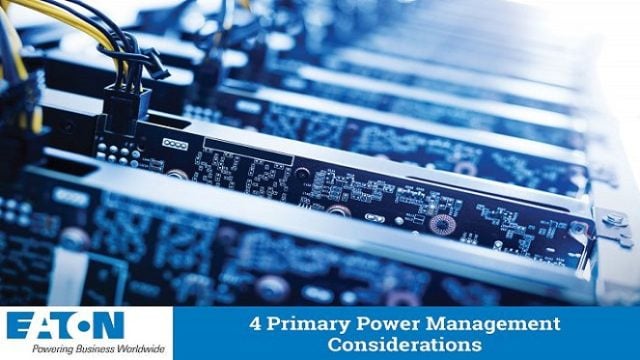
Getting the most from your power management solutions comes down to a number of factors, from IT application all the way to management and maintenance. Having a clear idea of your current systems will go a long way in determining your power management requirements. In this guide, we share some of the most important things to consider.

Power Management Factors To Keep In Mind
To get started, here are a few important power management factors to keep in mind.
You need to consider how often IT hardware is refreshed and maintained, as well as your current power distribution equipment. You also need to check that critical switches on converged data-voice networks are protected. If you have virtualised services, you should think about how they might affect UPS equipment. You will also need to consider the effect of lost or corrupted data in the event of lost power.
You need to know what size UPS is needed, in kVA or W. Other things to consider for power protection include current site voltage availability, required voltage, runtime needed, potential size or clearance restrictions, bypass requirements, input and output connections that may be needed, whether there are generators on-site, whether redundancy is needed, and whether UPS solutions need to scale.
Next, you need to consider how power will be distributed from the UPS to your various equipment. What will your distribution devices metre, monitor and manage? You also need to consider organisation, to determine whether you will need racks, enclosures, floor stands, rail kits or other equipment. You will need to check whether unorganised cables may affect efficiency or cause safety problems.
Finally, it’s time to think about management and maintenance. Think about whether you will need to have scheduled shutdowns. Consider whether you will monitor UPS and rack distribution units remotely and whether you want to include remote notifications. Consider how UPS software will manage virtual servers and whether it can integrate with virtualisation platforms. Then, think about whether factory response will be needed in the event that issues are registered. Determine whether preventative maintenance is needed and make sure that you have recently checked batteries in current UPS systems.
Once you have gone through these considerations, it should be much simpler to go ahead with your power management plans knowing that everything is ready and in place.
Learn how Eaton is powering businesses & homes everywhere and can help you setup a proper UPS system and infrastructure.

© Copyright 2024 Tarsus Distribution